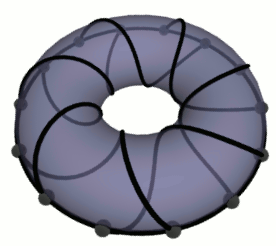Toroidal graph

In mathematics, a graph G is toroidal if it can be embedded on the torus. In other words, the graph's vertices can be placed on a torus such that no edges cross. Usually, it is assumed that G is also non-planar.
Examples
The Heawood graph, the complete graph K7 (and hence K5 and K6), the Petersen graph (and hence the complete bipartite graph K3,3, since the Petersen graph contains a subdivision of it), the Blanuša snarks,[1] and all Möbius ladders are toroidal. More generally, any graph with crossing number 1 is toroidal. Some graphs with greater crossing numbers are also toroidal: the Möbius–Kantor graph, for example, has crossing number 4 and is toroidal.[2]
Properties
Any toroidal graph has chromatic number at most 7.[3] The complete graph K7 provides an example of toroidal graph with chromatic number 7.[4]
Any triangle-free toroidal graph has chromatic number at most 4.[5]
By a result analogous to Fáry's theorem, any toroidal graph may be drawn with straight edges in a rectangle with periodic boundary conditions.[6] Furthermore, the analogue of Tutte's spring theorem applies in this case.[7] Toroidal graphs also have book embeddings with at most 7 pages.[8]
See also
Notes
References
- Chartrand, Gary; Zhang, Ping (2008), Chromatic graph theory, CRC Press, ISBN 9781584888000.
- Endo, Toshiki (1997), "The pagenumber of toroidal graphs is at most seven", Discrete Mathematics, 175 (1–3): 87–96, doi:10.1016/S0012-365X(96)00144-6, MR 1475841.
- Gortler, Steven J.; Gotsman, Craig; Thurston, Dylan (2006), "Discrete one-forms on meshes and applications to 3D mesh parameterization", Computer Aided Geometric Design, 23 (2): 83–112, doi:10.1016/j.cagd.2005.05.002, MR 2189438.
- Heawood, P. J. (1890), "Map colouring theorems", Quarterly J. Math. Oxford Ser., 24: 322–339.
- Kocay, W.; Neilson, D.; Szypowski, R. (2001), "Drawing graphs on the torus" (PDF), Ars Combinatoria, 59: 259–277, MR 1832459.
- Kronk, Hudson V.; White, Arthur T. (1972), "A 4-color theorem for toroidal graphs", Proceedings of the American Mathematical Society, 34 (1), American Mathematical Society: 83–86, doi:10.2307/2037902, JSTOR 2037902, MR 0291019.
- Marušič, Dragan; Pisanski, Tomaž (2000), "The remarkable generalized Petersen graph G(8,3)", Math. Slovaca, 50: 117–121.
- Neufeld, Eugene; Myrvold, Wendy (1997), "Practical toroidality testing", Proceedings of the Eighth Annual ACM-SIAM Symposium on Discrete Algorithms, pp. 574–580.
- Orbanić, Alen; Pisanski, Tomaž; Randić, Milan; Servatius, Brigitte (2004), "Blanuša double", Math. Commun., 9 (1): 91–103.
